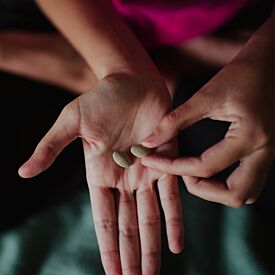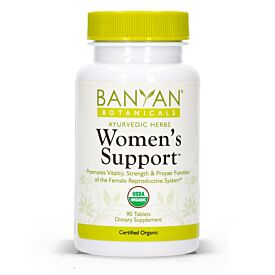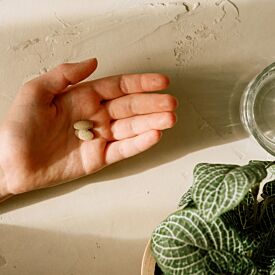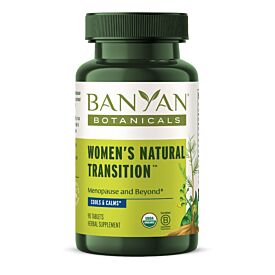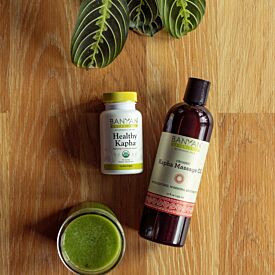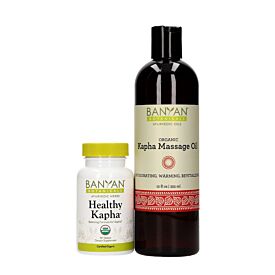Redefining Menopause with Ayurveda
Menopause, or “the change” as it’s lovingly referred to in the English language, is something that everyone with an ovary will go through, and yet many feel unprepared for the transition. In fact, over 80 percent experience some physiological or psychological discomfort around the time of menopause.1
Menopause is defined as a cessation of the menses for an extended period of time, typically considered at least 12 months. It is correlated with age and a reduction in the activity of the organs of the female reproductive system.
Psychologically, there are innumerable thoughts and emotions that we may have about this experience, and these can be culturally and socially influenced. Some are happy to stop experiencing periods, while others are very sad, worried, or conflicted about it.
Physically, there are many shifts that occur, some of which can be quite daunting. With a little help from Ayurveda, perhaps “the change” can be met with more comfort and a greater trust in the inherent wisdom of the body.
Menopause as a Rite of Passage
Many question whether their periods should stop in the first place, and if they really want them to. Let’s be real—there are a lot of stories, myths, experiences, emotions, and inherited belief systems wrapped up in the relationship between our worth and value and our ability to bear children.
However, we know that our bodies existed, thrived, and functioned well before our menses, so isn’t it also likely possible that our bodies can function well when we’re done with our menses too?
Ayurveda recognizes the body as having several natural phases, and menopause is an event which occurs during the transition to the last major phase of life. Ideally, this is a time when life experience and wisdom has been gained, meaningful relationships have been navigated and cultivated, and energy can be spent in new and different ways.
Much like how the body will utilize its resources differently in different parts of the body after menopause, we can also transition into making new and updated decisions about how to spend our energy and time.
Like all transitions, the transition through menopause is an incredible time for self-development and cultivating new passions. So let’s celebrate menopause as a rite of passage and get curious about the evolution of our bodies!
Perimenopause: The Transition to Menopause
As we approach the naturally occurring cessation of menstrual cycles, we will go through an earlier transition period, called perimenopause. Perimenopause is a bit like when the leaves on a tree begin to display their array of bright, bold colors before they fall from the tree. We can’t help but marvel at how beautiful they are, even though we know this phase is coming to an end soon.
During this time, we may experience some menstrual symptoms that may not have been common in earlier years, such as heavier bleeding, more painful periods, or disruptions in the timing of our cycle from month to month.
There may be other changes as well, such as difficulty sleeping, hot flashes, vaginal dryness, disrupted sex drive, or mood swings. In Ayurveda, most of these experiences are associated with high vata dosha.
When human forms change through their major seasons, sometimes the transitions can feel a little bit bumpy. If you’ve ever watched a child grow, you can see that some of the developmental processes that take place can be quite painful. For example, ever see a teething child cry? It can be quite challenging when we see that a normal biological event is creating pain or suffering for an individual.
It’s important to understand that perimenopause isn’t the cause of the symptoms of discomfort. Rather, perimenopause is actually being driven by the same factors that are influencing these associated discomforts: an increase of vata, a shift in the flow patterns in our bodies, and a decrease of agni (digestion) and ojas (vitality).
As we age, our bodily tissues exhibit more qualities of light, dry vata, even when we do not have a vata constitution, because it is the nature of vata to increase as we age. We can see these qualities show up in the natural thinning of our skin and hair, in our beautiful wrinkles, and in the slow cessation of our menstrual fluids.
When vata increases, we know it’s possible for the other doshas to increase as well. And since it is common to experience decreases in agni and ojas as we age, we're invited to tend these aspects of our health with even more attention and care.
I’m a big fan of preparation before going through a major transition, and the season of perimenopause is a great time to focus on self-care and self-study to intimately learn about the body’s processing. Times in our life when we have big transitions often raise the erratic nature of vata, and these times can be great teachers if we allow them to be.
If we are focusing on self-care and paying close attention to our body, then we are more likely to notice how our body responds to change. This might give us some clues about how the body will handle the transitions surrounding menopause.
How to Support Menopause with Ayurveda
Transitions of any nature are always easier when the body’s biological humors, or doshas, are in proper balance and when the bodily tissues are developing well. Our lifestyle practices, diet, and environment are all contributing factors to the state of our doshas and the health of our tissues.
What does a “healthy tissue” look like, anyway? It is easy to get confused about what a healthy tissue is as we age because we have become used to the tissues of our younger bodies and we assume that those young tissues are the standard for health.
The trick is to embrace our well-earned wrinkles and changes as a natural season of life, while also doing what we can to nourish and preserve the vital, life-giving fluids of our bodies.
Welcome in Herbs
The Ayurvedic herbal pharmacopeia has much to offer for rebalancing the body during the transition of menopause. Herbal allies like shatavari, ashwagandha, brahmi, and ashoka help bring balance to the reproductive system and support greater comfort through perimenopausal challenges.
Women’s Natural Transition tablets bring nourishment and balance to the female reproductive and hormonal system, help cool and soothe excess heat in the body, and support emotions of courage and love.
In addition, there are some Ayurvedic practices in which specific herbal preparations are delivered locally to the pelvic area via direct application, liquids, oils, steam, and even smoke. Keep in mind that these methods should be practiced only with the guidance of a trained Ayurvedic practitioner because the specific herbal blend will differ depending on each person's uterine, pelvic, and even skin condition.
Find Support in Your Daily Routine
One of the most supportive influences in any transition, in addition to loving support, is to have maintained a close observational relationship with one’s body throughout life. This way, we can learn to spot the first signs of an imbalance before it derails us and employ tactics that help regain balance.
Cultivating a daily self-care routine is an excellent way to stay empowered and healthy on the way to, during, and over the threshold of menopause. A daily routine can be as simple or elaborate as you like, incorporating nourishing practices like abhyanga, meditation, and gentle exercise, or anything that helps you maintain a loving, compassionate relationship with your body.
Even some yoga practices are very beneficial, specifically for this time of life. For example, mula bandha, or the contraction of the pelvic floor muscles in the uro-genital area—commonly known as a Kegel exercise—can bring extra blood flow and fluids to soothe vaginal dryness.
Whatever your daily routine and self-nurturing practices look like, this is part of the self-study that I mentioned earlier. And when this knowledge is coupled with the understanding that things are actually supposed to change at some point, well, that is the wisdom that leads to greater health and longevity.
Celebrating Your Wise Body
Even though many of us have not been taught to think so, menopause can be a sacred event in our lives. The perimenopausal transition is an opportunity to learn more about our body’s natural wisdom, to show gratitude for the years of menses that we’ve had, and to open to the new ways we can shine our light in the world.
Remember, the transition to menopause is a normal, natural process. And while that doesn’t necessarily mean it’s easy, few things that are really beautiful ever are. The more you can support yourself and your body through this time, the more empowered you will feel to embrace your thriving wellness throughout the later seasons of your life.




